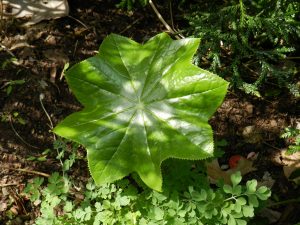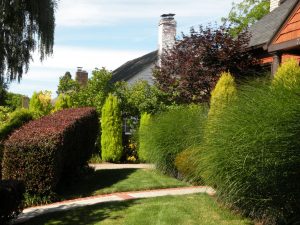 Although I’ve heard about them for years, I’ve never met the O’Byrnes but, after reading A Tapestry Garden, I feel as though I’ve encountered friends who share my love of gardening. For us, it is play, not work, and the concept of low-maintenance gardening rarely enters our minds.
Although I’ve heard about them for years, I’ve never met the O’Byrnes but, after reading A Tapestry Garden, I feel as though I’ve encountered friends who share my love of gardening. For us, it is play, not work, and the concept of low-maintenance gardening rarely enters our minds.
Although they are avid plant collectors, the O’Byrnes have never lost sight of the need to keep design principles in mind, varying foliage forms and textures, layering with low groundcovers up to tall trees, always maintaining visual interest.

Podophyllum pleianthum (Chinese Mayapple)
In discussing their shade garden, I appreciated the reminder that while yellow foliage loses its brightness in shade, silver foliage becomes more silver in shade. I was also overcome with plant lust for the many species of Podophyllum they use for texture and color. Many are hardy to zone 6 and a few are hardy to zone 5. These are woefully underused shade lovers. The explanation of the plants they use in the woodland garden, interweaving their bloom times, illustrates how designers may achieve the holy grail of a garden that is always interesting.
Although the discussion of plants is always fascinating, I loved the cultural tips that appeared throughout, e.g the caution that one should not plant conifers too closely lest branches be shaded, a condition that usually results in death of some branches. Another is a reminder that finding plants for sunny, dry sites is not as simple as it might be appear because, although many plants may be hardy, they cannot tolerate wet roots during the winter. I’ve always believed, incorrectly it seems, that heathers don’t survive in my garden because they need dry soil but Marietta says that they will be long-lived if planted in well-draining, moist soil. Guess I’ll try again.

Conifer garden with ornamental grasses
As a designer, I appreciated the comment that a collection is not a garden, that one needs a series of paths that provide movement through the garden as well as other plants that partner well with the collection. For instance, in the conifer garden, plants with softer texture were essential.
Sadly, our world seems to be riven with division but, as Marietta points out, “denizens from multitudes of countries of origin” co-exist in chaotic harmony in their garden. I know that the emphasis today is on using native plants but there is room in our gardens and landscapes for all.
During my reading, I took many notes about plants and combinations I want to try. This book is not for everyone but, for plant-a holics, it is a treasure trove of information about unusual plants.


0 Comments